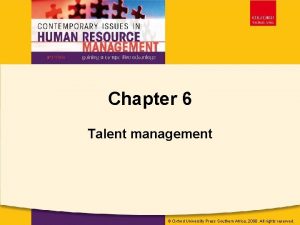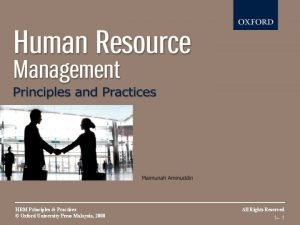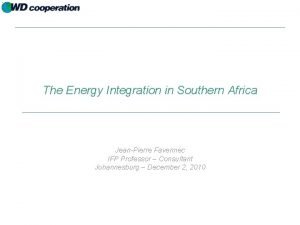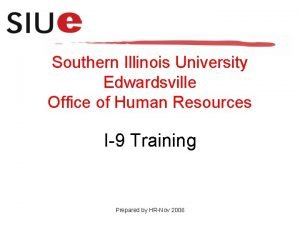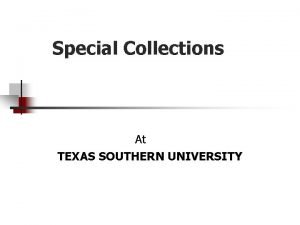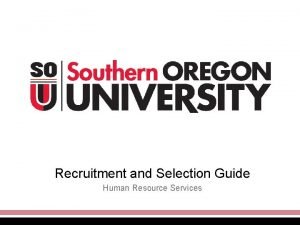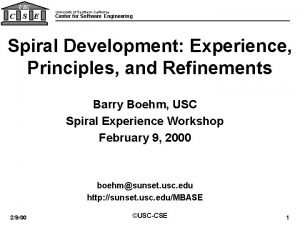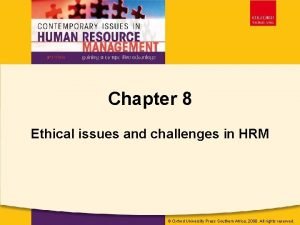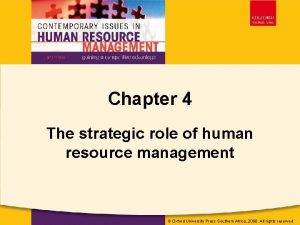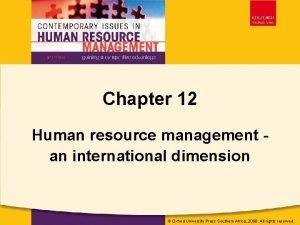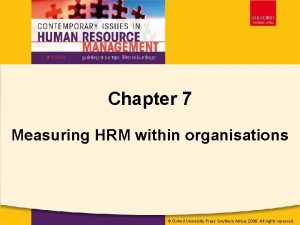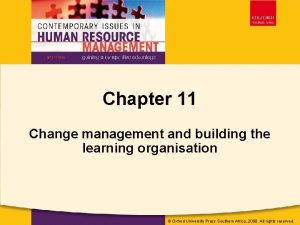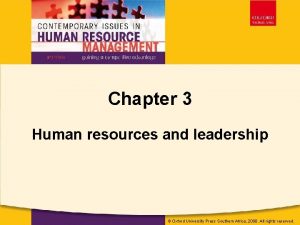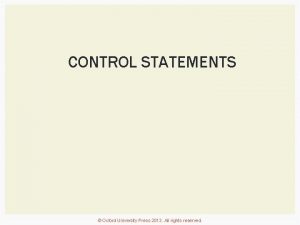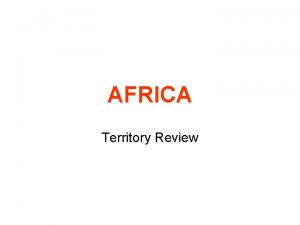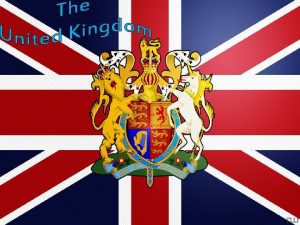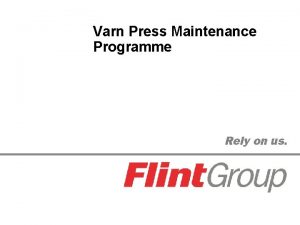Oxford University Press Southern Africa 2008 All rights
































- Slides: 32

© Oxford University Press Southern Africa, 2008. All rights reserved. Chapter 7 Measuring HRM within organisations © Oxford University Press Southern Africa, 2008. All rights reserved.

© Oxford University Press Southern Africa, 2008. All rights reserved. Learning outcomes After reading this chapter you should be able to: • identify the key forces driving the use of Scorecards within organisations • list the three different Scorecards available to measure a company's performance • identify the components of the Balanced Scorecard, the HR Scorecard and the Workforce Scorecard • list the stakeholders needed to implement the Scorecards successfully within organisations

© Oxford University Press Southern Africa, 2008. All rights reserved. Chapter Content • Opening case: IBM’s HR takes a risk • Introduction • Identifying three new performance measurement instruments – Balanced Scorecard – HR Scorecard – Workforce Scorecard • Considers each of these instruments in detail by looking at: – composition – implementation – stakeholders involved

The balanced scorecard

© Oxford University Press Southern Africa, 2008. All rights reserved. The balanced scorecard • Kaplan & Norton – four important perspectives: – customer perspective – internal perspective – innovation and learning perspective – financial perspective • forces managers to focus only on the measures that are most critical

© Oxford University Press Southern Africa, 2008. All rights reserved. The balanced scorecard • To activate scorecard, managers must translate the company goals relating to the four perspectives into specific measures that reflect the factors that really matter: – customer perspective § how do customers see us? § measuring lead time of receiving orders and then delivering, quality, performance, service and cost § articulate goals for time, quality, performance, service and cost § goals must then be translated into specific measures (eg. get standard products to the market sooner) § to track the performance - company can either obtain the information internally or externally from customers

© Oxford University Press Southern Africa, 2008. All rights reserved. The balanced scorecard – internal perspective § What must we excel at? What must the company do internally to meet its customers’ expectations? § determine the most critical processes and competencies, specify measures for cycle times, quality, employee skills and productivity § translate goals into specific measures (eg. obtain a submicron technology capability) § bring measures for goals to attention of employees at this low level – they have clear target for actions, decisions and improvement activities enabling them to obtain overall mission § availability of information systems plays important role in monitoring progress

© Oxford University Press Southern Africa, 2008. All rights reserved. The balanced scorecard – innovation and learning perspective § Can we continue to improve and create value? § monitoring the company's ability to launch new products, create more value for customers and improve operating efficiencies § previous 2 identified the parameters that should be considered most important for competitive success - in ever changing world continual improvements will need to be made to existing products and processes and companies need the ability to introduce entirely new products § one measure can be the % of sales from new products (if sales go down, the company can establish whether it is due to the design of the product) § some organisations have replaced the innovation and learning perspective with broader people/human capital element perspective

© Oxford University Press Southern Africa, 2008. All rights reserved. The balanced scorecard – financial perspective § How do we look to shareholders? § measuring cash flow, quarterly sales, growth, operating income by division and increased market share by segment, and return on equity § articulate goals for these components (profitability, growth and shareholder value) § translate goals into specific measure (are the company’s strategy, implementation and execution contributing to bottom-line improvement? )


© Oxford University Press Southern Africa, 2008. All rights reserved. Who is responsible for compiling the balanced scorecard? • cannot be the responsibility of one person only but a Balanced Scorecard team • What will this team look like? – involvement of members from top management - can influence change brought about by this process at the very top of the organisation – the higher the level of people one can assemble from across the business units within an organisation, the better – advantages of this approach: § with rank comes experience and knowledge, credibility, and the ability to interact with the most senior executives at regular intervals

© Oxford University Press Southern Africa, 2008. All rights reserved. Who is responsible for compiling the balanced scorecard? – senior members from support groups such as Human Resources, Finance and Information Technology (IT) will also be necessary • conflict is at the essence of Balanced Scorecard development and thus one trait all team members must possess is the ability to work comfortably in an atmosphere of conflict • team leader = Balanced Scorecard champion – responsibilities of this person will include: § to schedule meetings, track results, ensure the distribution of materials, interact with top management and provide guidance on tough issues

Cascading the balanced scorecard

© Oxford University Press Southern Africa, 2008. All rights reserved. The HR scorecard • takes Balanced Scorecard to the next level • seeks to strengthen a weak aspect of the Balanced Scorecard approach - the question of how best to integrate HR's role into the company's measurement of business performance • Benefits of HR Scorecard according to Becker, Huselid and Ulrich: – reinforces distinction between HR “do-ables” and “deliverables” – enables you to control costs and create value – measures leading indicators – assesses HR's contribution to strategy implementation and the “bottom line” – lets HR professionals effectively manage their strategic responsibilities – it encourages flexibility and change

© Oxford University Press Southern Africa, 2008. All rights reserved. Building an HR scorecard • not one-time or annual event • HR resource leaders must stay attuned to changes in the performance drivers that HR is supporting within the company • if drivers change (or the key HR deliverables that support them) the Scorecard must shift accordingly

© Oxford University Press Southern Africa, 2008. All rights reserved. Steps to implementing HR scorecard an

© Oxford University Press Southern Africa, 2008. All rights reserved. How does the HR scorecard work? • • • helps to integrate HR into the organisational performance management and measurement system by identifying the points of intersection between HR and the organisation's strategy (strategic HR deliverables) strategic HR outcomes that enable the execution of the organisation's strategy two categories of deliverables: performance drivers performance enablers core people-related capabilities/assets (employee productivity/satisfaction) reinforce performance drivers

Linking the HR scorecard to the Business Scorecard

© Oxford University Press Southern Africa, 2008. All rights reserved. Linking HR scorecard to Business Scorecard • four major dimensions in the HR Scorecard: – key human resource deliverables that will leverage HR's role in company's overall strategy (e. g. the extent to which employees' behaviours change in ways that make a real difference to the business) – high-performance work system (e. g. the key HR policies and practices that must be in place and implemented well to achieve the organisation's strategy)

© Oxford University Press Southern Africa, 2008. All rights reserved. Linking HR scorecard to Scorecard Business – extent to which that system is aligned with the company strategy (e. g. the extent to which the HR practices that you deploy are internally consistent and not working at cross purposes and are really the right ones to drive organisational strategy) – efficiency with which the deliverables are generated (e. g. the extent to which you are efficient in delivering HR services to the organisation)


© Oxford University Press Southern Africa, 2008. All rights reserved. Success of HR scorecard • • investment in HR systems hiring HR employees with the required competencies communicating the Scorecard throughout the organisation weaving the HR results into reward and recognition systems drive the workforce behaviours with substantial impact on business process success that leads to customer success and ultimately result in financial success companies that are successful operationally and with their customers should also experience company financial success continuous feedback loop

© Oxford University Press Southern Africa, 2008. All rights reserved. Workforce scorecard • Huselid, Becker and Beatty: – it is not the activity that counts, but the impact of the activity on organisational outcomes that meant the most to companies – example - it is not the number of days of training that were provided, but the impact the training had on the individual and the organisation – companies needed a business strategy, a strategy for the HR function and a workforce strategy – these strategies are operationalised in the Balanced Scorecard, the HR Scorecard and the Workforce Scorecard – Workforce Scorecard is a crucial lever in the strategy execution process within companies

© Oxford University Press Southern Africa, 2008. All rights reserved. Composition of the Workforce scorecard • workforce investments should help execute strategy through the components of: – workforce mind-set and culture – workforce competencies – workforce behaviours • these components become the link between: – strategy – HR investments – the workforce leads to workforce success

Composition of the Workforce scorecard

© Oxford University Press Southern Africa, 2008. All rights reserved. Composition of the Workforce scorecard • Workforce success – most important dimension of the Workforce Scorecard → it captures the "bottom line" of the workforce performance • the measures that reflect how well the workforce has contributed to the execution of the company's strategy (number and quality of customer complaints, the number of new distributors and the response time for customer inquiries)

© Oxford University Press Southern Africa, 2008. All rights reserved. Composition of the Workforce scorecard • Workforce mindset and culture – Does the workforce understand the company strategy? Does the culture within the organisation support the execution of this strategy? • organisations create norms and expectations the workforce needs to understand • this creates the culture of the organisation shaping employee behaviour • culture can be measured and assessed in terms of impact on the company's strategic success (the extent to which the company strategy is clearly and widely understood, the extent to which the average employee can describe the company's HR strategy, extent to which employees take pride in working for the company)

© Oxford University Press Southern Africa, 2008. All rights reserved. Composition of the Workforce scorecard • Leadership and workforce behaviours – Are the employees consistently behaving in a way that will lead to the achievement of the company's strategic objectives? • leaders and employees must behave in ways that are consistent with the strategy for it to be executed • behaviours can be defined and measured to ensure that leaders and employees do what the strategy suggests needs to be done (effectiveness in dealing with poor performers, percent of employees making suggestions, percent retention of core competency workforces)

© Oxford University Press Southern Africa, 2008. All rights reserved. Composition of the Workforce scorecard • What measures should be adopted? – managers can be held accountable for their words and actions relative to people and the workforce success, the mindset, capabilities and behaviours they create – managers who do not create workforce success can be identified, targeted and developed or moved out – HR professionals and HR management system lay the foundation for building the workforce into a strategic asset BUT the responsibility for workforce success increasingly falls to line managers who perform most of the workforce management activities in any company

© Oxford University Press Southern Africa, 2008. All rights reserved. Implementation of the scorecard Workforce • According to Huselid et al successful implementation is based on 3 challenges: – perspective challenge - do all our managers understand how workforce capabilities and behaviours drive strategy execution? – metrics challenge - have we identified (and collected) the right measures of workforce success, leadership and workforce behaviours, workforce competencies, and workforce culture and mindset? – execution challenge - do our managers have the access, capability and motivation to use the data to communicate strategic intent and monitor progress towards strategy execution?

© Oxford University Press Southern Africa, 2008. All rights reserved. Practical implementation of the Workforce scorecard • Step 1: development of a clear statement of the company's business strategies and the strategic capabilities needed to execute those strategies • Step 2: identification of key jobs or "A" positions as well as "A" performance that will be required within these positions to successfully execute the company's strategy • Step 3: HR management system which must elicit the needed competencies and behaviours from the workforce which ultimately drives the company's success

© Oxford University Press Southern Africa, 2008. All rights reserved. Practical implementation of the Workforce scorecard • To be successful: – team of people should be involved, including: § the CEO and the executive team § line managers § the workforce § HR
 Oxford university press south africa
Oxford university press south africa Damon zucca
Damon zucca M.swan (oxford university press)
M.swan (oxford university press) Strlen(“oxford university press”) is
Strlen(“oxford university press”) is Oxford university press malaysia
Oxford university press malaysia Oxford university press
Oxford university press Oxford university press
Oxford university press 2008 2008
2008 2008 Nonqawuse
Nonqawuse Chapter 24 southern africa
Chapter 24 southern africa Volvo group southern africa
Volvo group southern africa Boundless southern africa
Boundless southern africa Southern african transport conference
Southern african transport conference Chartered secretaries southern africa
Chartered secretaries southern africa Southern africa
Southern africa Ketobe
Ketobe Cambridge university press 2011
Cambridge university press 2011 Vilnius university press
Vilnius university press Cambridge university press 2011
Cambridge university press 2011 Positive rights and negative rights
Positive rights and negative rights Riparian doctrine
Riparian doctrine Legal rights and moral rights
Legal rights and moral rights Legal rights vs moral rights
Legal rights vs moral rights Positive vs negative rights
Positive vs negative rights Negative right
Negative right Negative rights vs positive rights
Negative rights vs positive rights Positive rights and negative rights
Positive rights and negative rights Name three lines
Name three lines Southern federal university
Southern federal university Siue hr forms
Siue hr forms Texas southern university library
Texas southern university library Southern oregon university human resources
Southern oregon university human resources University of southern california
University of southern california
